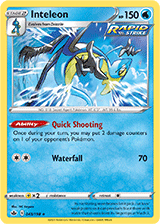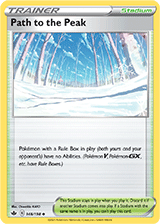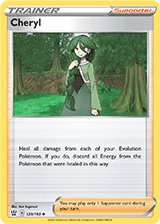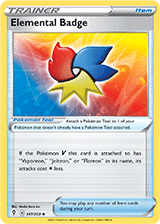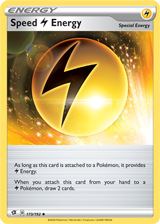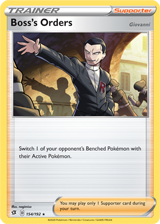Unsurprisingly, our example deck puts Jolteon VMAX in the
spotlight for several good reasons. Before checking out its attack, let’s look
at its raw stats. For a Pokémon VMAX, 300 HP is on the lighter side compared to
its counterparts (like Vaporeon VMAX and Flareon VMAX), but its free Retreat Cost
makes up for these comparatively lower Hit Points. To make things even better, Jolteon V also has no Retreat
Cost, despite being a Basic Pokémon. This is quite a valuable feature on a card
and gives you a permanent pivot-Pokémon throughout the game. Combine this with Jolteon
VMAX’s attack, and this Pokémon line becomes one of the most flexible cards
from the Sword & Shield—Evolving Skies expansion.
Jolteon VMAX’s Max Thunder Rumble attack does 100 damage to
the opponent’s Active Pokémon for just 1 Lightning and 1 Colorless Energy. In
addition, this attack will do a whopping 100 damage to an opposing Benched
Pokémon that has any damage counters on it! With the rotation of Mew from the Sun & Moon—Unbroken
Bonds expansion out of the Standard format, there is nothing left in the
format to stop attacks from hitting the Bench anymore. To make sure you can use
this attack for full value every turn, it’s important that the deck has
multiple ways of damaging the opponent’s Benched Pokémon to set up Max Thunder
Rumble.
This deck takes advantage of the popular Inteleon
consistency engine, giving you easy access to all Trainer cards thanks to the Shady
Dealings Ability of Drizzile and
Inteleon from the Sword
& Shield expansion. But what really makes the Inteleon line a perfect
fit for Jolteon VMAX is the Sword & Shield—Chilling Reign Inteleon and its Quick Shooting Ability.
Thanks to Quick Shooting, you can damage a Pokémon of your choice every turn,
making sure Max Thunder Rumble can reach its maximum potential.
Unfortunately, this Ability is featured on a Stage 2 Pokémon
while the main attacker, Jolteon VMAX, could be ready to attack as early as the
second turn, as it only needs to evolve once. Luckily, there is an easy
solution to the problem in the form of Galarian Zigzagoon,
also from the Sword & Shield expansion. Its Headbutt Tantrum Ability
can put a damage counter on any Pokémon in play, allowing you to activate the
snipe effect of Max Thunder Rumble effectively until you can set up an Inteleon
with Quick Shooting. Galarian Zigzagoon will be easily accessible with the hefty
amount of Quick Balls and
Level Balls in the deck,
but our example list still runs a second copy because of the importance of
getting damage in play. It can be a real setback if you discover that your only
copy of Galarian Zigzagoon is among your Prize cards; and having access to
extra damage counters over the course of the game is never a bad idea. Remember
that Scoop Up Net can be
used to reset Headbutt Tantrum and let you dish out even more damage if needed.
In addition, Scoop Up Net can also be used effectively by picking up a Shady
Dealings Inteleon line to get additional uses out of them.
Pokémon Search: A good way to accompany the Inteleon
line is by having lots of Pokémon search cards: Evolution Incense, Quick Ball,
and Level Ball. With these cards, you’ll be able to consistently search out
multiple Sobble and ways
to evolve them, resulting in a lot of Shady Dealings to openly access anything else
you will need. Of course, these cards will also be great for finding Jolteon V
and Jolteon VMAX early on, which you should look for in combination with Galarian
Zigzagoon to activate Max Thunder Rumble.
Stadiums: The Stadium card of choice is Path to the Peak. Since this
deck takes advantage of the Inteleon engine and neither Jolteon V nor Jolteon
VMAX has an Ability, there is nothing that Path of the Peak will block on your
side of the field. But it can spell a ton of trouble for the opponent: One of
the most notable Abilities this Stadium will turn off is Zamazenta V‘s Dauntless Shield Ability
that prevents Pokémon VMAX from doing any damage to it. Turning off this
Ability will be crucial and can make all the difference in turning a loss into
a win.
Supporters: Our list goes with the tried and tested
Supporter lineup consisting of Professor’s Research,
Marnie, and Boss’s Orders. These cards
provide the deck with some of the strongest ways to draw cards in the Standard
format, along with the best way to target the opponent’s Benched Pokémon. I’ve
also added a less common Supporter, Cheryl.
This Supporter can be very situational, but it has the potential to change the
outcome of the game drastically. When played, Cheryl will heal all damage
counters from all your Evolution Pokémon for the cost of the Energy attached to
them. Since Jolteon VMAX needs 2 Energy to use its attack, this might seem like
a problem. Luckily, there is an incredible Tool that can help you out…
Tools: In Sword & Shield—Evolving Skies,
all of Eevee’s Evolutions get their own corresponding powerful Pokémon Tool
card, with Jolteon getting Elemental Badge.
When attached, it enables Jolteon V and Jolteon VMAX to attack for one less Colorless
Energy, meaning a single Lightning Energy is all you need to unleash the Max
Thunder Rumble attack. Cheryl now becomes much easier to use, as you only need
to attach a single Energy card from the hand to fuel the attack once again
after healing.
The Elemental Badge also lets you spend the first turn of
the game using Sobble’s Keep Calling attack to fill up the Bench. This is important
if you happen to go second in the game, as you don’t have any other great
attacks to use on the first turn. Jolteon V having free Retreat Cost also makes
it easier to get Sobble into the Active Spot to use its attack.
Energy: With the use of Elemental Badge, this deck
does not need to run many Energy but it’s still important to be able to find
them at the right time. Speed Lightning Energy
is an excellent Energy to help you draw extra cards, and a couple of Capture Energy will provide more
ways to find Jolteon V on the first turn. There are also a few Basic Energy included,
which can be retrieved by Energy Search. The inclusion of Energy Search lets Shady
Dealings access Lightning Energy when needed, which dramatically increases the deck’s
chances of finding that crucial Energy attachment.
Given the choice, you should always elect to go first with
this deck, as Jolteon VMAX does not need an impressive setup to start dishing
out massive damage. On the first turn of the game, you will have one very clear
goal: get Jolteon V into play. This is crucial so you can start attacking on the
second turn and begin applying pressure. Missing Jolteon V on the first turn
can result in the game snowballing out of your control fast, and in the worst
case, your Jolteon V will be sniped immediately when it does hit the Bench
later.
Even if you go second, there are a couple good options you
can utilize to execute your strategy. As previously mentioned, using Keep
Calling is a great way to kickstart your setup, as Jolteon VMAX will be able to
attack on the following turn thanks to the Elemental Badge. However, Jolteon
V’s first Thunder Spear attack could also be something to consider, as its 20
damage to any target provides an excellent setup for Jolteon VMAX’s Max Thunder
Rumble. Thunder Spear can work as a substitute for Galarian Zigzagoon. However,
keep in mind that most of the time Sobble’s Keep Calling attack will still be
the better option (if available).
In my opinion, the biggest advantage this deck has is its flexibility
in placing damage counters in the most effective way possible. In the current
metagame, no matter what your opponent is doing, getting six Prize cards should
be manageable with only three Max Thunder Rumble attacks. One of the most common
ways for you to draw all your Prize cards is to focus solely on two Pokémon
VMAX. Most of them have a range of 300–340 HP, meaning that with a few Headbutt
Tantrum and Quick Shooting Abilities, you will be able to do the extra damage
needed to take them down.
You should also not be afraid to target a Benched Pokémon V
before it evolves into a Pokémon VMAX either. This will often put pressure on
your opponent’s main attackers. And should the opponent choose not to evolve
the Pokémon V, you can often target a single-Prize Pokémon for the last Prize
card instead. Focusing on your opponent’s attackers instead of their support
Pokémon also makes it more difficult for your opponent to attack with an
undamaged target in the late game. This could be a huge deal, as it takes the
pressure off of you to find a Boss’s Orders.
Also, don’t forget that Inteleon has Weakness to Lightning-type
Pokémon; you can use that to your advantage when playing against other decks featuring
the Inteleon engine.
Even after all the praise, Jolteon VMAX is not an unbeatable
deck. The easiest way for you to overcome this deck is by taking advantage of Jolteon’s
Fighting-type Weakness. This is where the relatively light HP of 300 comes back
to haunt Jolteon VMAX, as both Rapid Strike Urshifu V
and Rapid Strike Urshifu VMAX
do a perfect base damage of 150 for a clean Knock Out once you factor in
the additional damage from Weakness. Single Strike Urshifu V and Single Strike Urshifu VMAX pose a similar problem and can
effortlessly Knock Out Jolteon VMAX in a single hit, as well.
Another way to overcome this powerful Lightning-type deck is
to take advantage of its predictable nature. If you’re playing a deck that can
also run Cheryl, you could completely wipe off a turn or two of attacks and
effort from the Jolteon VMAX player.
My final tip is to be careful with every Pokémon you put on
the Bench when playing against Jolteon VMAX. With some clever Bench management,
you could force the Jolteon VMAX player to attack less critical targets and
gain the upper hand.
Without a doubt, Jolteon VMAX featuring the Inteleon engine is
one of the most consistent decks in the current Standard format. Its glaring Fighting-type
Weakness keeps it somewhat in check, but otherwise the deck has an excellent
game plan it can execute without much trouble, game after game. I highly
recommend giving Jolteon VMAX a try if you haven’t already. The deck is almost guaranteed
to bring you a ton of fun and some speedy games.
And be sure to check out Pokemon.com/Strategy for more Pokémon TCG strategy and analysis.
About the Writer

Tord Reklev
Tord Reklev is a contributing writer for Pokemon.com. He is a longtime player from Norway, playing the game since he was 6 years old. He is notable for being the only Masters Division player to win the North America, Europe, and Oceania Internationals, and he recently made Top 4 at the World Championships. Outside of the game, he is a student and enjoys playing tennis. You can find him at most big events, and can follow him on Twitter at @TordReklev.

Source: Pokemon


